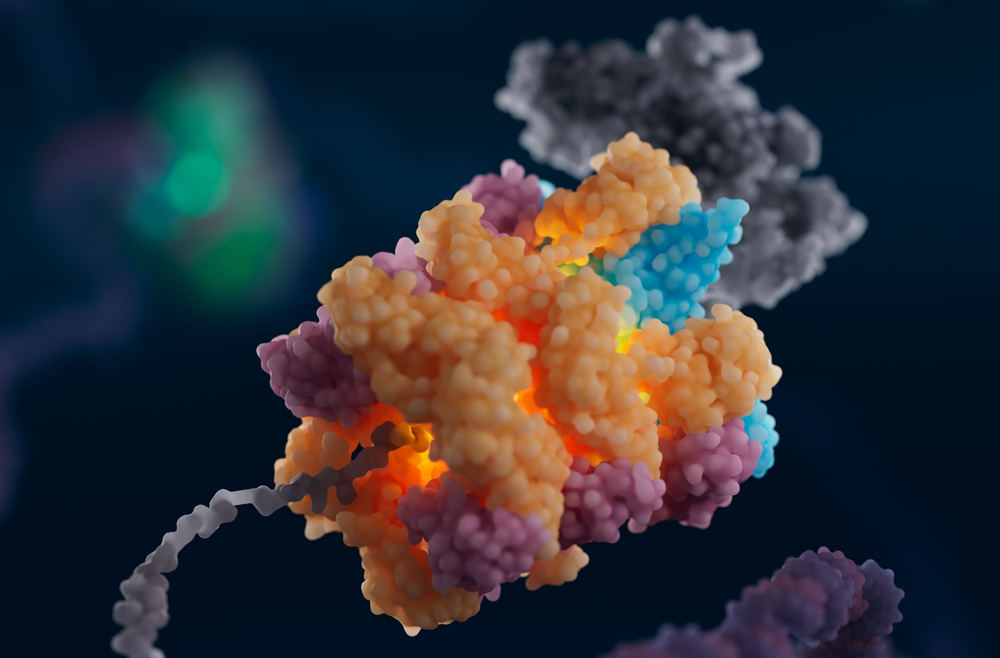
When cells in the human body divide, they must first make accurate copies of their DNA. The DNA replication exercise is one of the most important processes in all living organisms and is fraught with risks of mutation, which can lead to cell death or cancer. Now, in a landmark finding, biologists from the Perelman School of Medicine at the University of Pennsylvania and from the University of Leeds have identified a multi-protein “machine” in cells that helps govern the pausing or stopping of DNA replication to ensure its smooth progress.
The discovery, published today in Cell, advances the understanding of DNA replication, helps explain a puzzling set of genetic diseases, and could inform the development of future treatments for neurologic and developmental disorders.
“We’ve found what appears to be a critical quality-control mechanism in cells,” said senior co-corresponding author Roger Greenberg MD, PhD, the J. Samuel Staub, M.D. Professor in the department of Cancer Biology, director of the Penn Center for Genome Integrity, and director of Basic Science at the Basser Center for BRCA at Penn Medicine. “Trillions of cells in our body divide every single day, and this requires accurate replication of our genomes. Our work describes a new mechanism that regulates protein stability in replicating DNA. We now know a bit more about an important step in this complex biological process.”
An enduring mystery of “lagging strand” DNA replication
The DNA replication process is carried out by multiple protein complexes with highly specialized functions, including the unwinding of DNA and the copying of the two unwound DNA strands. The process is akin to a factory assembly line where balls made up of massive, crumpled strings of data are unraveled, allowing specific pieces to be trimmed and copied. Biologists know a good deal about how this process starts and proceeds, but know less about how it is stopped or paused.
Prior studies have identified proteins that stop replication along one DNA strand—the “leading strand”—by inducing the disassembly and recycling of DNA-replication components on that strand. How replication is stopped on the other strand—the “lagging strand”—has been a mystery.
In the study, the researchers used cryo-electron microscopy, CRISPR-based mutation analyses, and other advanced techniques to identify a protein complex that has a central replication-stopping role for the lagging strand.
They showed that this four-protein machine, which they call 55LCC, binds to DNA and its associated replication complex. Powered by two motor-like enzymes called ATPases, 55LCC appears to unfold the tightly folded replication complex, allowing it to be chopped up by protein-snipping enzymes and cleared away. The experiments suggested that this stopping or pausing function of 55LCC is crucial for the smooth progression of DNA replication. When 55LCC is absent, the investigators found, replication is likely to become stuck, and affected cells cease dividing.
“We eventually see massive changes to genome stability in these cells, as their chromosomes fail to segregate properly during cell division,” Greenberg said.
The researchers suspect that 55LCC may be involved in regulating not just the DNA replication process associated with cell division, but also when DNA damaging lesions block replication.
Clinical relevance of a basic science discovery
Inherited mutations in enzymes that help make up 55LCC are known to be associated with childhood syndromes involving hearing loss, cognitive and movement impairments, and epilepsy. The scientists showed in their experiments that these disease-causing mutations tend to reduce the structural stability of 55LCC or affect its interactions with other proteins.
“This work hopefully marks the start of a deeper understanding of these severe neurodevelopmental syndromes,” Greenberg said. “Ultimately, the implications of this finding could be much broader. It could lead to ways to mitigate the clinical issues associated with syndromes stemming from 55LCC dysfunction, which include epilepsy, hearing loss, mental retardation, and bone marrow insufficiency.”
55LCC may also turn out to be a more general tool for protein recycling—another process critical to the health of cells. Greenberg and his team are continuing to study how 55LCC works and is regulated, including understanding the precise signal that tells 55LCC to become active and start unfolding a DNA replication complex.

